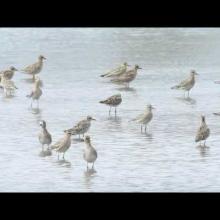

Join BirdNote tomorrow, November 30th!
Illustrator David Sibley and actor H. Jon Benjamin will face off in the bird illustration battle of the century during BirdNote's Year-end Celebration and Auction!
Shorebirds such as these Pacific Golden-Plovers have a built-in map and a built-in compass. Many night-flying migrants use star patterns to orient themselves, and the fact that the sun always sets in the west makes it a compass point for a bird about to take off on a night flight. Perhaps the most amazing thing is birds' ability to use variations in the Earth's magnetic field to mark their approximate position.
Want more flexibility for listening to BirdNote? Sign up for BirdNote weekly preview or the podcast.
BirdNote®
How Shorebirds Find Their Way
Written by Dennis Paulson
This is BirdNote!
[Pacific Golden-Plover calls]
Shorebirds such as the Pacific Golden-Plover are famous for their ability to navigate over great distances. Some of these plovers breed in Alaska and winter in Hawaii, and each spring and fall, they fly the 2500 miles between them. How do they find their way on these long flights? [Pacific Golden-Plover calls] [Introduce musical selection from Symphony 6 Op. 104 by Sibelius ]
We actually know very little about how shorebirds navigate, but research on songbirds has given us some clues. We now think that migrating birds have a built-in map and a built-in compass to determine both where they are and where they’re going.
Many night-flying migrants use star patterns to orient themselves. And the fact that the sun always sets in the west makes it a compass point for a bird about to take off on a night flight.
Perhaps the most amazing thing about the way birds navigate is their ability to use variations in the Earth’s magnetic field to mark their approximate position. Evidence for this comes from studies of rainbow trout, sea turtles, and homing pigeons. Surely shorebirds are just as capable.
For BirdNote I’m Mary McCann. [Music continues]
###
Call of the Pacific Golden-Plover provided by The Macaulay Library at the Cornell Lab of Ornithology, Ithaca, New York. Recorded by W.Ward.
Waves recorded by Kessler Productions
Musical selection drawn from Symphony 6 Op. 104, composer Jean Sibelius, performed by the Gothenburg Symphony Orchestra, BIS
BirdNote’s theme music was composed and played by Nancy Rumbel and John Kessler.
Producer: John Kessler
Executive Producer: Chris Peterson
© 2015 Tune In to Nature.org October 2013/2015 Narrator: Mary McCann
ID#102507navigateKPLU migration-08b





